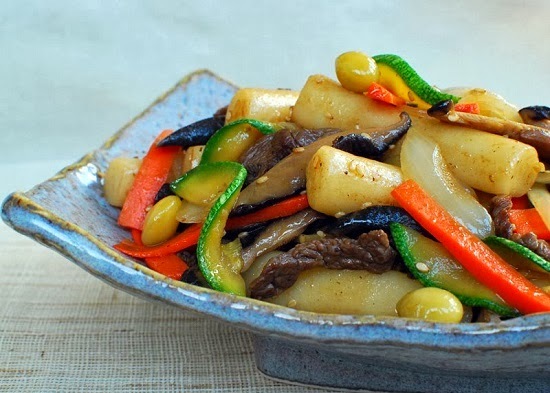Gungjung tteokbokki
Stir-fried rice cake with beef and vegetables
By Korea HeraldPublished : Jan. 24, 2014 - 19:27

Gungjung tteokbokki is the traditional version of tteokbokki. Gungjung means “royal court” in Korean, and this version dates back to the Joseon Dynasty (1392-1910). As the name suggests, it was part of the royal cuisine and regarded as a high-class dish ― an interesting contrast to the modern spicy version which is pretty much street food.
 One story behind the origin of this royal dish is that it was inspired by japchae (stir-fried starch noodles with vegetables) and created to help regain the king’s appetite. In fact, gungjung tteokbokki is also known as tteokjapchae perhaps because it is made in a similar fashion to japchae. Unlike today’s spicy version, the traditional version is mildly flavored with soy sauce and stir-fried rather than braised, which is why it’s also called ganjang (soy sauce) tteokbokki. This deliciously colorful dish will be a great addition to your Gujeong (Lunar New Year) feast!
One story behind the origin of this royal dish is that it was inspired by japchae (stir-fried starch noodles with vegetables) and created to help regain the king’s appetite. In fact, gungjung tteokbokki is also known as tteokjapchae perhaps because it is made in a similar fashion to japchae. Unlike today’s spicy version, the traditional version is mildly flavored with soy sauce and stir-fried rather than braised, which is why it’s also called ganjang (soy sauce) tteokbokki. This deliciously colorful dish will be a great addition to your Gujeong (Lunar New Year) feast!
Ingredients:
● 450 grams thin garaetteok or tteokbokki tteok (5-centimeter-long pieces)
● 1 tablespoon soy sauce
● 1 teaspoon sesame oil
● 100 grams lean beef (sirloin, eye round or rib eye)
● 3 or 4 shiitake mushrooms (fresh or soaked if dried)
● 1/2 medium-size zucchini
● 1 medium-size carrot
● 1/2 medium-size sweet onion
● 1 to 2 scallions
● Salt
● Vegetable or canola oil
Sauce:
● 3 tablespoons soy sauce
● 2 teaspoons rice wine (or mirim)
● 1 tablespoon sugar
● 2 teaspoons sesame oil
● 1 teaspoon sesame seeds
● 2 teaspoons minced garlic
● A pinch of pepper
Optional garnish:
● Ginkgo nuts or pine nuts
Bring water to a boil in a medium-size pot. Add the rice cake pieces. Boil until all the pieces float to the top. The time required will vary depending on the condition of the rice cakes. The rice cakes will be very soft when cooked, but they will become harder as they cool. Drain them out with a sieve. Do not rinse. Mix with a tablespoon of soy sauce and 1 teaspoon of sesame oil. Set aside.
Mix the sauce ingredients well and set aside.
Thinly slice the beef into 5-centimeter-long strips. Cut stems off the mushrooms and slice into thin strips. Place the beef and mushrooms in a bowl, and mix in a tablespoon of prepared sauce. Marinate while preparing the other ingredients.
Cut the zucchini in half lengthwise and then thinly slice crosswise and slightly diagonally to make the cuts longer. Generously sprinkle salt over zucchini slices, and set aside for 10-15 minutes. Squeeze out excess liquid from the zucchini by hand. Slice the onion and carrot into thin, 5-centimeter-long strips. Cut the scallion into similar lengths.
In a lightly heated and oiled skillet, stir-fry the onion, carrot and zucchini over medium-high heat for about 2 minutes. Add the scallion at the end. Transfer to a plate.
In the same skillet, cook the beef and mushrooms over medium-high heat until the meat is cooked through, 1-2 minutes. Reduce the heat to medium-low. Add the rice cakes and stir-fry for another minute or two. Turn the heat off. Add the vegetables, including optional ginkgo or pine nuts, and the remaining sauce. Stir well. Adjust the seasoning with additional soy sauce or sugar as necessary. Serve warm.
By Ro Hyo-sun
For more recipes visit www.koreanbapsang.com.
 One story behind the origin of this royal dish is that it was inspired by japchae (stir-fried starch noodles with vegetables) and created to help regain the king’s appetite. In fact, gungjung tteokbokki is also known as tteokjapchae perhaps because it is made in a similar fashion to japchae. Unlike today’s spicy version, the traditional version is mildly flavored with soy sauce and stir-fried rather than braised, which is why it’s also called ganjang (soy sauce) tteokbokki. This deliciously colorful dish will be a great addition to your Gujeong (Lunar New Year) feast!
One story behind the origin of this royal dish is that it was inspired by japchae (stir-fried starch noodles with vegetables) and created to help regain the king’s appetite. In fact, gungjung tteokbokki is also known as tteokjapchae perhaps because it is made in a similar fashion to japchae. Unlike today’s spicy version, the traditional version is mildly flavored with soy sauce and stir-fried rather than braised, which is why it’s also called ganjang (soy sauce) tteokbokki. This deliciously colorful dish will be a great addition to your Gujeong (Lunar New Year) feast!Ingredients:
● 450 grams thin garaetteok or tteokbokki tteok (5-centimeter-long pieces)
● 1 tablespoon soy sauce
● 1 teaspoon sesame oil
● 100 grams lean beef (sirloin, eye round or rib eye)
● 3 or 4 shiitake mushrooms (fresh or soaked if dried)
● 1/2 medium-size zucchini
● 1 medium-size carrot
● 1/2 medium-size sweet onion
● 1 to 2 scallions
● Salt
● Vegetable or canola oil
Sauce:
● 3 tablespoons soy sauce
● 2 teaspoons rice wine (or mirim)
● 1 tablespoon sugar
● 2 teaspoons sesame oil
● 1 teaspoon sesame seeds
● 2 teaspoons minced garlic
● A pinch of pepper
Optional garnish:
● Ginkgo nuts or pine nuts
Bring water to a boil in a medium-size pot. Add the rice cake pieces. Boil until all the pieces float to the top. The time required will vary depending on the condition of the rice cakes. The rice cakes will be very soft when cooked, but they will become harder as they cool. Drain them out with a sieve. Do not rinse. Mix with a tablespoon of soy sauce and 1 teaspoon of sesame oil. Set aside.
Mix the sauce ingredients well and set aside.
Thinly slice the beef into 5-centimeter-long strips. Cut stems off the mushrooms and slice into thin strips. Place the beef and mushrooms in a bowl, and mix in a tablespoon of prepared sauce. Marinate while preparing the other ingredients.
Cut the zucchini in half lengthwise and then thinly slice crosswise and slightly diagonally to make the cuts longer. Generously sprinkle salt over zucchini slices, and set aside for 10-15 minutes. Squeeze out excess liquid from the zucchini by hand. Slice the onion and carrot into thin, 5-centimeter-long strips. Cut the scallion into similar lengths.
In a lightly heated and oiled skillet, stir-fry the onion, carrot and zucchini over medium-high heat for about 2 minutes. Add the scallion at the end. Transfer to a plate.
In the same skillet, cook the beef and mushrooms over medium-high heat until the meat is cooked through, 1-2 minutes. Reduce the heat to medium-low. Add the rice cakes and stir-fry for another minute or two. Turn the heat off. Add the vegetables, including optional ginkgo or pine nuts, and the remaining sauce. Stir well. Adjust the seasoning with additional soy sauce or sugar as necessary. Serve warm.
By Ro Hyo-sun
For more recipes visit www.koreanbapsang.com.
-
Articles by Korea Herald



















![[Today’s K-pop] Treasure to publish magazine for debut anniversary](http://res.heraldm.com/phpwas/restmb_idxmake.php?idx=642&simg=/content/image/2024/07/26/20240726050551_0.jpg&u=)